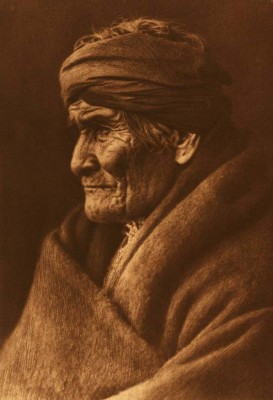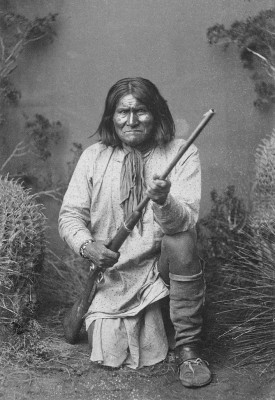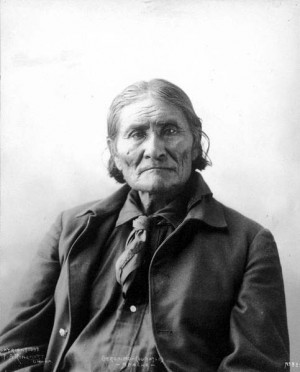| Geronimo | |
|---|---|
 |
|
| Apache Leader | |
| Born | 1829 Gila River, Bedonkoheland |
| Died | 1909 Fort Sill, Oklahoma, United States |
| Tribe | Bedonkohe Apache |
| Native Name | Goyaale “One who yawns” |
Geronimo (1829-1909) was an eminent figure of Bedonkohe Apache tribe. He led the war against the U.S. and Mexico for many decades so that the Apache tribal lands could be expanded. The name Geronimo means “the one who yawns.” He was given this name during the Apache wars in one of the battles against Mexico.
In 1858 a group of Mexican soldiers attacked his village and killed his wife, mother and three children. It was then that he joined hands with others to respond to the killings. He made his name as a war chief who was notorious for raiding Mexican towns and provinces. He then went on to attack American locations across the Western Texas, New Mexico and Arizona.
In 1886, Geronimo gave in to the authorities of United States following a very long pursuit. Being a inmate of war during his elderly days, he came to be a celebrity in the region and appeared in many fairs. Still, he was restricted from going back to his land of birth. He died in 1909 following complications with pneumonia.
Geronimo’s early days
Geronimo was born near Turkey Creek which is a branch of the modern-day Gila River in New Mexico. His grandfather, known as Mako, was the chief of the Bendonkohe Apache. The parents of Geronimo raised him in accordance with the traditions and customs of the Apache people. After his father died, he was taken to Chihenne by his mother where he grew up. When he was 17 years old he wedded a woman by the name Alope of the band of Apache from Nedni-Chiricahua. Together they bore three children.
On March 6, 1858, when Geronimo and the other men were in the town trading, a group of soldiers from Sonora being led by Colonel Jose Maria Carrasco attacked the women and the children who had been left behind in the camp. Among the people who died were Geronimo’s mother, wife and children. This loss made him furious. From then on, together with his followers, he initiated attacks against any Mexicans that they would come across.
Geronimo later married a second wife by the name Chee-hash-kish and they had two children, Dohn-say and Chappo. He then took another wife by the name Nana-tha-thtith who gave him one child. He had several more wives including Zi-yeh, She-gha, Shtsha-she and Ih-tedda. In total he had nine wives with the last one being Azul.
His Religious background
 When he was young, Geronimo was raised in accordance with the religious beliefs of the Bedonkohe people. In an autobiography that he wrote in 1905, he said that the religious teachings he got from his tribe did not say where one goes after death. However the teachings did speak of another life after death. He said that they believed that one’s duty in the current life would impact the future life.
When he was young, Geronimo was raised in accordance with the religious beliefs of the Bedonkohe people. In an autobiography that he wrote in 1905, he said that the religious teachings he got from his tribe did not say where one goes after death. However the teachings did speak of another life after death. He said that they believed that one’s duty in the current life would impact the future life.
In the later years, Geronimo embraced Christianity. He said that ever since he had become a prisoner he had received the lessons of the white man and perceived them to be better than his previously held beliefs. He said that he was not ashamed of being a Christian and he asked his native people to embrace Christianity. According to Geronimo there was no better religion than Christianity. In 1903 he became a member of the Dutch Reformed Church but was expelled four years later for gambling.
The Kas-Ki-Yeh Massacre
Raids on Chihuahua and Sonora took place for the first time at the end of 17th century. By 1835 Mexico had begun to offer rewards for Apache scalps. Mangas Coloradas became the chief two years later and started a chain of vengeful attacks against the Mexicans. These attacks and raids were so brutal and numerous that none of the areas were safe. Between the years 1820 and 1835 a total of 5,000 Mexicans died and some 100 settlements were destroyed. Geronimo became the war chief and notoriously urged for more raids and wars against the Mexican provinces.
These attacks became a daily occurrence. In December, 1860, the encampment of Bedonkohes was attacked by a group of 30 miners on the Western bank of the Mimbers River. A historian by the name R. Sweeney states that these miners killed several Indians, wounded many and captured 13 women and children. This heated up the retaliatory attacks by the Apache against the citizens of U.S. and their property.
According to Geronimo, the attack happened in the afternoon when they were returning from town. They met women and children who told them that their camp had been attacked by the Mexican troops. They learned that the men on guard had been killed, the ponies captured, arms taken, supplies destroyed and many women and children killed. Together the survivors took what they could find and assembled by the river. After the counting who was left, is when Geronimo realized that his aged mother, three children and his young wife were among those killed.
It was then that Geronimo decided to go on a revenge mission for the slaying of his family. According to National Geographic, Sanora’s governor claimed that over the five months that Geronimo and his men spent in the wild in 1886, they slaughtered a total of 500 to 600 Mexicans.
The Casa Grande Massacre
 The Mexicans attacked the Apache once more in 1873. The men fought for months before deciding to sign a peace agreement at Casa Grande. Once the Apache had agreed on the terms, the Mexicans gave them mescal to make them intoxicated. Then the Mexicans attacked and killed twenty Apaches and captured many more. This forced the Apaches to retreat again.
The Mexicans attacked the Apache once more in 1873. The men fought for months before deciding to sign a peace agreement at Casa Grande. Once the Apache had agreed on the terms, the Mexicans gave them mescal to make them intoxicated. Then the Mexicans attacked and killed twenty Apaches and captured many more. This forced the Apaches to retreat again.
The forces of Geronimo became outnumbered, but this did not stop him from fighting against the Mexican and U.S. troops. He was renowned for his brave exploits and his many escapes that took place between 1858 and 1886.
In his last days of his military career, Geronimo led a small gang consisting of thirty six women, men and children. Together they evaded American and Mexican troops for more than a year, making him the most popular Native American of that time. He even earned the title of the “worst Indian to ever live” among the white settlers.
Geronimo Campaign
In 1886, Captain Henry Lawton and Charles B. Gatewood were selected by General Nelson to lead an expedition that was to capture Geronimo. They were given strict orders to pursue Geronimo to the South of U.S.-Mexico boundary, where he took refuge, subdue and present him to the United States either dead or alive. Geronimo surrendered officially to the U.S. on August 4, 1886 in Arizona, in a place known as Skeleton Canyon.
Life in Prison
Geronimo was put into prison at Fort Sam Houston together with other Apaches and Apache scouts that aided the army in tracking him down. They were held there for six months before being sent to Pensacola, Florida at Fort Pickens. In 1887, Geronimo’s family was reunited when they were taken to the Mount Vernon barracks in Alabama where they stayed for 7 years. They were later taken to Fort Sill, Oklahoma in 1894.
During Geronimo’s later years he spent his days as a prisoner and a celebrity. He appeared at many fairs, such as the 1904 World’s Fair, held in St. Louis. In 1905 he also got an opportunity to ride in President Theodore Roosevelt’s inauguration parade. Around the same time he was approached by S.M. Barrett for an interview and he published his own book.
His Death
In the February of 1909, Geronimo fell from his horse when he was riding home and lied in the cold the entire evening before a colleague found him. He caught a cold and eventually succumbed to pneumonia while still serving his prison term in Fort Sill, Oklahoma.